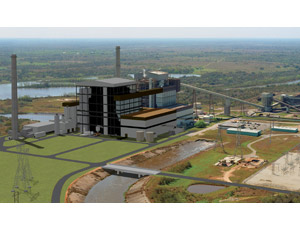Amid political and environmental conflicts over Texas air quality, International Power announced a long-awaited powerplant expansion in South Texas. Barring intercession by the courts, the Coleto Creek Unit Two project is expected to create more than 1,000 construction jobs by 2015, when it is scheduled to come on line.

The $1.4-billion expansion project will add a 650-MW coal-burning power plant to International Power’s existing Coleto Creek Unit One at its power station in Goliad County. Michael Fields, director of expansion for International Power, says that after a six-month open-bid period, the company expects to sign the engineering, procurement and construction agreement early next year with the design-build joint-venture team of Zachry Industrial, San Antonio, Burns & McDonnell, Kansas City, Mo.; and Mitsubishi Power Systems, Lake Mary, Fla.
The South Texas Electric Cooperative, part owners in the project, say the expansion will provide electricity to 65 counties, create jobs and fuel economic growth.
When Coleto Creek’s 632-MW Unit One went into service in 1980, infrastructure for all coal delivery and handling and the cooling reservoir were sized for a second unit, Fields says.
Both units will use low-sulfur Powder River Basin coal from Wyoming. Unit Two, when completed, can be retrofitted with the latest carbon-capture technology when it becomes available. Until then, it will use “ultra-super critical technology” to efficiently reduce CO2 emissions, Fields says. “The nitrogen oxide burners inside the furnace will produce less NOx than conventional burners,” he says.
Fields says local support for the project is “tremendous,” noting that the city of Victoria passed a resolution supporting the project, while elected officials from Goliad “traveled to Austin and went in front of TCEQ commissioners.”
The Texas Commission on Environmental Quality awarded an air permit for the new unit on May 3. But opponents, including the Lone Star Chapter of The Sierra Club, worry about air pollution. The Sierra Club has threatened to sue the Environmental Protection Agency in federal court if the agency does not force Texas to comply with the clean-air act. That may not be necessary, however, as a recently appointed regional EPA administrator is threatening to take over aspects of Texas air-quality permitting.
The Sierra Club charges the TCEQ’s “flawed permitting program” allows proposed coal-fired powerplants to move forward with air-pollution permit limits that do not protect public health and the environment as state and federal laws require. “TCEQ does not even require readily available air monitors on the stacks for pollutants,” says Eva Hernandez, organizer for the Sierra Club’s Beyond Coal Campaign in Austin.
“The bottom line is it’s a dirty coal plant,’ Hernandez says. “We don’t need to invest in old technology.”
Scrubbers and other new technologies have only limited value: “Once the coal is burned and goes into coal-ash waste ponds, it can seep into any groundwater source, lake or stream,” Hernandez says. Utilities want to “grandfather” Texas coal plants before new federal standards go into law, she adds.


Post a comment to this article
Report Abusive Comment